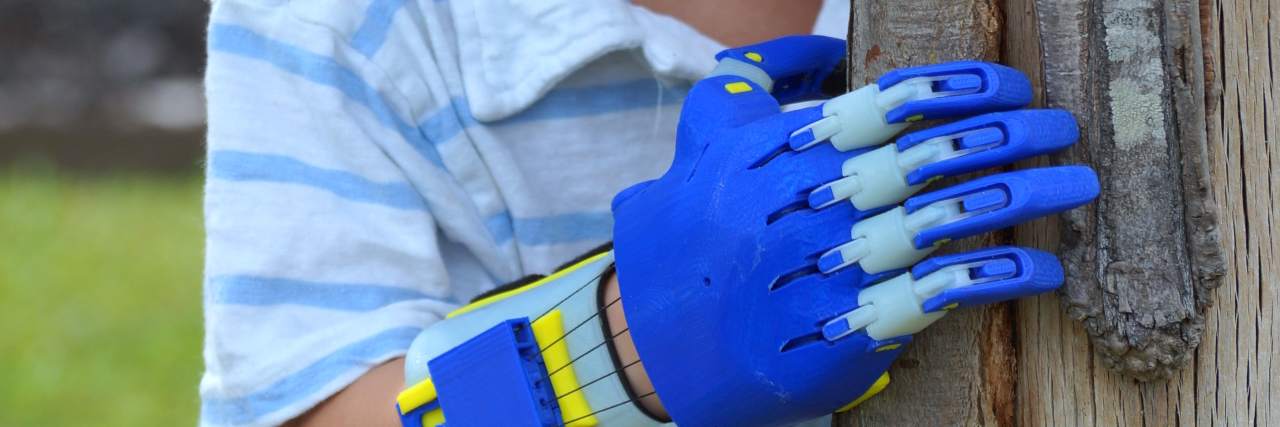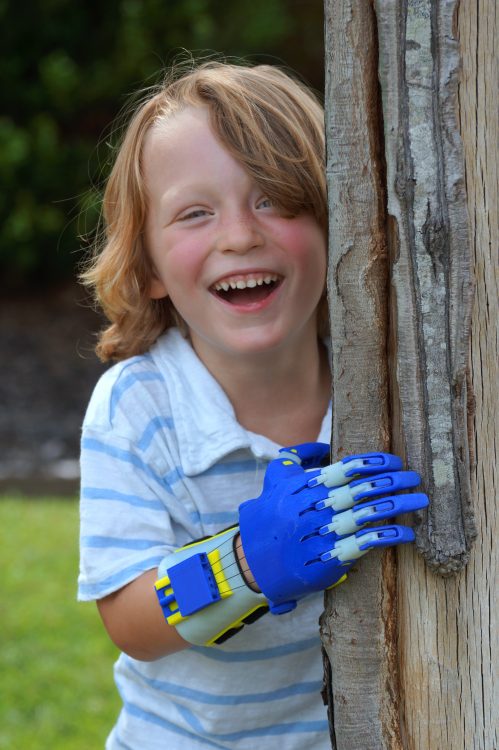I’ve never been a fan of fairy tales. They give the impression that everything will end happily ever after. But in real life, that isn’t always the case…or is it?
My son, Cameron (or Cam, as we often call him), was born with a condition called amniotic band syndrome (ABS). I don’t want to bore you with details, but it’s a spontaneous condition where fibrous bands form inside of the amniotic sac with the baby and then tangle around the baby while he or she is still developing. Cases like this are rare and typically end in a loss of the pregnancy.
In our case though, Cam’s vital organs and face remained safely intact. Happy ending? Not quite. All four of his limbs and scalp were still affected by the bands. As a result, he was missing a thumb, toes, partial fingers had tangled and fused skin on most residual fingers, non-circulatory toes required amputation, and he had malformations and indentations of the scalp, wrist and calves. All of which have required 19 reconstructive procedures, six rounds of anesthesia, numerous skin grafts — both taken from his own hips and from cadaver skin cell growth — nine full arm and leg casts, and he still has more to come.
When Cameron was just under 2 years old, he started really noticing his differences; the short and missing fingers mostly. We have always been very open with him about his differences, the surgeries, talk about the good days as well as the bad; but at times, it was obvious that his differences bothered him. He would hold his little hands up to mine and compare them, then look back at his own and wrinkle his forehead. Sometimes, he would put his own two hands together and point out the differences between them as well.
Going out in public was the absolute hardest. People would stare, point and ask questions. Most didn’t mean any harm and simply let curiosity take control of their “filters.” I now like to call those “faulty filters.” These people felt they needed to know how his hands ended up the way they were. Some were very nice about it… but some were not. We have been asked things like: What was “wrong” with him? Was it something I did or didn’t do during the pregnancy that caused it? Was he neglected or being harmed? Was it contagious? Would his limbs ever grow back? Why does he have all of “those” scars?
Being a parent, I think it’s only natural to want to “fix” everything for your child. This was something I could not fix, only try to make the best of it and keep things as upbeat and positive for him as possible. Some days, that was hard.
Every negative experience offered a “brick,” and I used these bricks to build a fortress — so to speak — around my son to protect him. When we went out, I would cover up his differences the best I could. I wasn’t embarrassed by him; I wanted to protect him from people’s rude comments.
My plan was faulty though. People climbed the walls. They found other ways in. They still looked. They still pointed. They still talked about us. I was wearing myself out holding up the walls. I wouldn’t be able to protect him forever if I continued this way, but I didn’t know how to make things better either.
When Cam was still a baby, I made a Facebook page to educate my family and friends about amniotic band syndrome. His page was, and still is, used as an open diary into our world. My plan was simply to use it as a way of telling everyone at once what we were going though, sharing updates, photos and videos with long distance family and friends, and spreading awareness about ABS. However, it became so much more.
Cam’s page helped us connect to others around the world with differences similar to his. It also connected us to people who were interested in learning about medical conditions, to people who have been in similar shoes, those seeking or wanting to give advice, some who were pregnant themselves and had questions about getting checked for the condition, even helped open doors for us that we never would have found ourselves, and so much more!
I had every intension of changing the perception of differences, but then those bricks just kept showing up at my feet, needing to be placed somewhere in the fortress. And then, I found myself trapped between putting him out there so he can change the world or protecting him from the world.
When Cam was about 2 years old, he and I happened to be looking into more ABS and alternative prosthetic devices to help him hold onto a bicycle handle bar when we came across 3D printed prosthetics. You see, traditional prosthetics were financially not an option for us and the hospitals that help provide typical free or low cost prosthetic devices couldn’t help since he wasn’t missing a full hand, just his fingers.
I submitted Cam’s application for a 3D printed hand only to find he would have to be at least 3 years old to be considered.
While waiting for Cam to reach the age limit for a 3D hand, we attended a limb difference camp where Cam was able to try on a 3D printed arm made by a nearby college student. He was amazed and told us that night he wanted a “robot hand” for his little hand. It was all he talked about after camp. I mean, he reminded us every single day.
I was honestly surprised by the impact that simple plastic hand had on my son. It further opened my eyes to the extent of Cam’s limb difference awareness, his vulnerability and feelings of being different, and how those feelings could very realistically affect his self-confidence as a result.
The day he turned 3, I resubmitted the application to get him a hand but was informed the age limit was now 5 or older. Devastated wasn’t even a strong enough word at this point.
As a very last resort, I messaged a friend of mine I’d made as a result of Cam’s Facebook page, who was able to immediately put me in contact with a teacher and two young sixth grade girls from Irmo SC. Fast forward a couple weeks through calls, emails and scheduling… we were heading out to get a hand!
Cam took right to the girls. He loved the hand! When it came time to leave the school, he was more interested in zooming cars around the racetrack with his new hand than going home.
The teachers and staff around the building each stopped us here or there to ask about his hands… but now, something was different.
I noticed right away the usual negative looks and long stares were replaced with, “Hey, check out that awesome hand!” and conversations about his limb differences were easy. The hand made a fantastic conversation piece and it was a great way to lead into why his hands are different in a fun and non-scary way.
I’ve known Cam could do anything he puts his mind to, even without a 3D printed helper hand. But to be able to give him the confidence and pure joy I saw in him immediately after putting the hand on is something I struggle to put into words. It was like we handed him a giant helping of confidence on a brightly colored platter! The “robot hand” is just part of our lives now. He doesn’t go anywhere without it. I grab for my keys and sunglasses, he grabs for his sunglasses and 3D printed hand.
After the struggles we faced getting a hand for Cam, we wanted to help. I learned how to make the hands for my own son and then started teaching him how to make his own. Cameron, now barely 5 years old, can fire up the computer and 3D printer, pull and scale the files, tell you where every single piece goes, measure and cut the cords, choose the tools needed to assemble the hands and put the printed pieces together in order. He also helps me tie the knots, cut out the materials, like the velcro and padding, and he makes an awesome tester in that he can tell me if it’s too hard to bend or “juuuust right.” Since some parts are tough, I do help with the pins and cords and of course never leave him alone with the printer because it does get extremely hot. He has been doing this since he was 3 and tells everyone he wants to be a “prosthetic doctor” when he grows up so he can “keep making free prosthetic devices for kids.” I don’t believe in fairy tales endings ,but… I think this is about as close as you get in real life!
Oh and that brick fortress? Its simply not needed anymore.
I have learned over the last five years that building fortress walls does not work. What does work is building your child up. Confidence is key! You have to find what that looks like in your life. For us, it’s spreading awareness, providing 3D printed devices to others, and working to help families who struggle with the same fears I am learning to face head-on.
There will be bad days, because there will always be people with faulty filters, but it’s what you make of those days that will change the way your child deals with his or her differences. Use them to teach lessons, not to build a fortress.
Follow us on Facebook and visit our website at www.DifferentHeroes.com to keep in touch, share your story, get a free hand or arm device for your child or get involved!
We want to hear your story. Become a Mighty contributor here.


